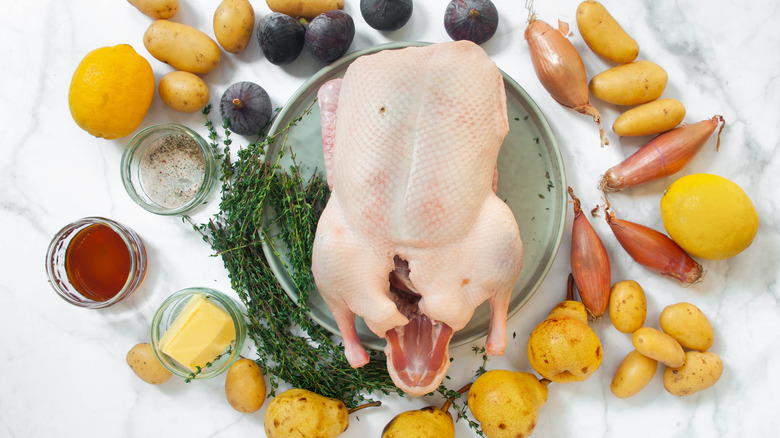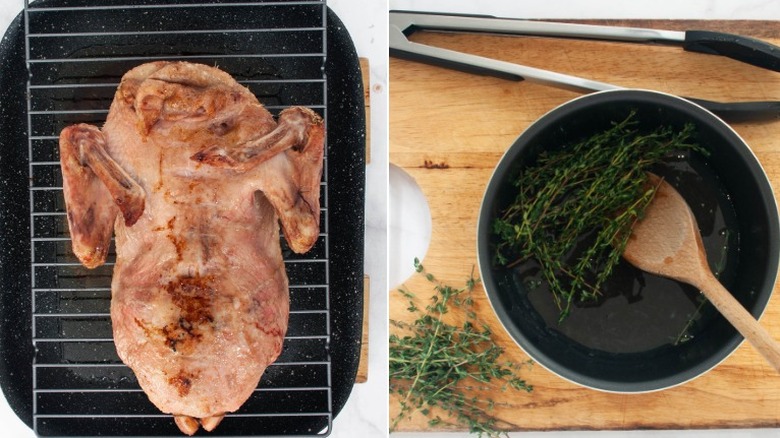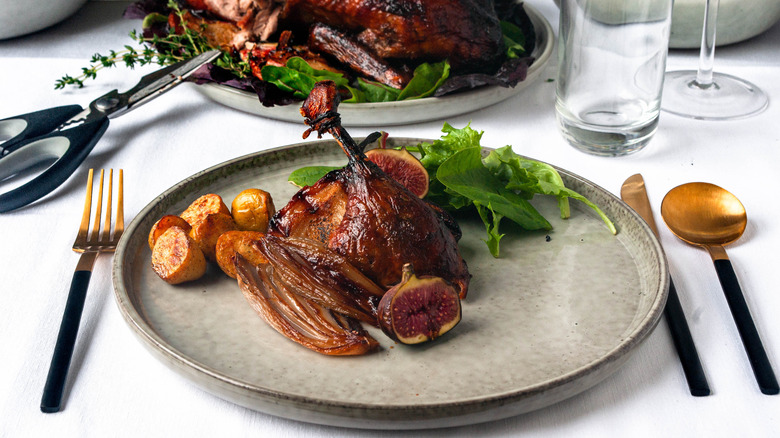Crispy Roast Duck Recipe
We may receive a commission on purchases made from links.
Beginner cooks, take note: You too can whip up a show-stopping duck centerpiece! Ausrine Zygaityte has developed a crispy roast duck recipe that ensures the best results for all. "I love duck because it is juicier than chicken," she says, "and you don't even need a sauce." Here, the duck is slow-roasted and then glazed with a magical lemon-honey concoction that burnishes the duck a gorgeous golden mahogany. "I especially prefer this recipe because it is the perfect combination of sweet and sour, which is complemented with incredibly crispy duck skin," says Zygaityte.
Duck is all dark meat, so if you're a person who eagerly tears into a chicken or turkey drumstick, this recipe is for you. Zygaityte balances the duck's richness with roasted fruits, and by tossing in shallots and baby potatoes, it's basically a sheet-pan dinner.
Gather together the ingredients for the crispy roast duck
Zygaityte creates bold flavors to accompany her duck. Duck is often roasted with fruit, which helps balance the meat's strong taste. Zygaityte uses Bartlett pears (also known as Williams pears), lemons, and fresh figs. When in season, they're one of the most luscious fruits. When roasted, their flavor deepens. Shallots and baby potatoes round out the meal.
Most of your attention, though, should go toward the duck. The type of duck you'll find either frozen or fresh in many supermarkets is Pekin duck (also called Long Island duck). It's inexpensive and can be cooked using several methods. Pekin ducks don't have as much breast meat as their heftier cousins, so for three people — and maybe four, if you stretch it out — look for a duck between five and six pounds.
Prepare and roast the potatoes, shallots, and fruit
Preheat the oven to 450 degrees Fahrenheit. Take the duck out of the refrigerator 30 minutes before preparing it. Zygaityte's recipe also includes a side dish of roasted baby potatoes, shallots, fresh figs, and Bartlett pears. You'll be roasting them first and then reheating them later after the duck has roasted.
Wash and cut the baby potatoes in half. Peel the three shallots and cut them in half lengthwise. Cut three pears in half, and scoop out the cores with a spoon or cut them out with a paring knife. Cut the figs in half vertically from the stem. Brush a roasting pan with canola oil or other oil with a high smoking point, and arrange the potatoes, shallots, figs, and pears.
If you would like a more interesting presentation, spray a baking rack with cooking spray and insert it into a baking sheet. Arrange the figs and pears on the rack. When roasted, the figs and pears will have "grill" marks left by the rack. Put the pan (or pan and tray) into the oven and roast for 30 minutes.
Make the fruit stuffing for the crispy roast duck
Zygaityte makes good use of lemons in her recipe by using the juice for the glaze and also putting them into the stuffing for the duck. Melt two tablespoons of butter in a medium-size, microwavable bowl in the microwave. Stir in the juice of one and a half lemons and one tablespoon of honey, and mix until well-combined. Cut up three figs, one or two Bartlett pears (depending on their size), and half of a lemon into eighths. Add them to the butter mixture and set the bowl aside.
Score the duck's skin, then stuff the duck
Duck is famous for the amount of fat that is rendered when it's roasted. To make sure that as much of the fat oozes out (which will then help crisp up the skin), you need to score the duck. But first, check the duck's skin for any leftover feathers. "If you enjoy eating the crispy skin," Zygaityte says, "I strongly recommend taking a tweezer and remove [them]."
Using a sharp paring knife, cut the skin in several angled cuts. Take care to not cut too deeply, or you'll cut the meat. Turn the duck 45 degrees, and score the duck again to create a crosshatch pattern. If you see any globules of fat hanging out of the duck cavity, trim them off with kitchen shears. There's more fat in the legs, and Zygaityte recommends scoring them and any other areas where you see fat.
Generously season the duck inside and out with kosher salt and pepper. Make sure to rub the seasoning into the cut skin. Stuff the fruit stuffing into the duck's cavity. Cross the duck's legs, and truss the bird by tying the legs up with kitchen twine. Zygaityte recommends lining a roasting pan with foil "to make the cleaning process a lot easier." Insert a roasting rack on top of the foil, and lay the duck breast-side up on the rack. Take the potatoes, shallots, figs, and pears out of the oven, and cover with foil.
Roast the duck and make the lemon-honey glaze
Put the duck into the oven and roast for 10 minutes. Lower the heat to 300 degrees, and roast the duck for another 50 minutes. Hereafter, you won't have to do much to the duck but turn it every 30 minutes to ensure even cooking and allow the duck's fat to drain as it's rendered.
While the duck is roasting, you can prepare the glaze. Combine the juice of two lemons, four tablespoons of honey, and a handful of fresh thyme in a saucepan. Heat over medium heat until the thyme turns brown. Remove the thyme sprigs and discard. Lower the heat, and simmer the glaze until it begins to thicken. Take the saucepan off of the heat, and set aside.
Glaze the duck and finish roasting
Your duck should be a beautiful golden color by now, but to get the burnished and crispy skin, it needs a final 15 minutes. Brush the duck all over with the lemon-honey-thyme glaze. Increase the oven temperature to 475 degrees, and return the duck to the oven. Roast the duck for 15 minutes, but keep an eye on it, since the honey in the glaze could easily burn.
After 15 minutes (or less), take the roasting pan out of the oven and let the duck rest for 15 minutes. Meanwhile, pop the pan(s) with the potatoes, shallots, figs, and pears back into the oven. The potatoes may need a little more time to be done — once the shallots, figs, and pears are warmed through, transfer them to a serving platter and tent loosely with foil.
Carve the crispy roast duck, and serve
Once it's rested, it's time to cut up that duck! It's really not difficult, especially with Zygaityte's easy way of doing it. First, snip off the kitchen twine from the tied legs with kitchen shears. Remove the stuffing and transfer it to a serving bowl. Holding one leg by the tip, use the shears to cut the leg away from the body. When you hit bone, bend the drumstick back, and it will pop right out. Repeat with the other drumstick.
Next, use the shears to cut off each wing. Finally, snip down the breast bone and separate the two halves. Arrange the potatoes, shallots, figs, and pears on plates with portions of duck, and spoon a little stuffing along the side. Enjoy a beautiful wine to complement this magnificent feast for a holiday or any special occasion that calls for an elegant meal.
Dishes that pair well with roast duck
Crispy Roast Duck Recipe
This duck is slow-roasted and then glazed with a magical lemon-honey concoction that burnishes the meat a gorgeous golden mahogany.

Ingredients
- 1 (5 to 6 pound) whole duck
- ½ pound baby potatoes
- 3 shallots
- 6 fresh figs
- 5 Bartlett pears
- 2 tablespoons butter
- 4 lemons, divided
- 5 tablespoons honey, divided
- Kosher salt
- Freshly ground pepper
- 1 bunch fresh thyme
Directions
- Preheat oven to 475 F.
- Take the duck out of the refrigerator 30 minutes before preparing it.
- Cut the baby potatoes, the shallots, three figs, and three pears in half. Arrange them on an oiled baking sheet. If you would like the fruit to have grill marks, insert a baking rack into a second baking sheet, and lay the figs and pears on top. Put the tray in the oven and roast 30 minutes while you prepare the duck and fruit stuffing.
- Melt the butter, and add it to a mixing bowl. Mix in the juice of 1 ½ lemons and 1 tablespoon of honey.
- Cut the remaining figs and pears and half a lemon into eighths, and add them to the lemon-butter mixture.
- Using a sharp knife, score the duck's skin in a crosshatch pattern. Avoid cutting into the duck's meat.
- Generously season the duck inside and out with kosher salt and freshly ground pepper.
- Trim any excess fat around the duck's cavity. Stuff the duck's cavity with the fruit stuffing, then pour in the lemon juice from the bowl.
- Criss-cross the duck's legs, and secure with kitchen twine. Place the duck breast-side up on a rack inside of a roasting pan.
- Put the duck into the preheated oven, and roast for 10 minutes. Lower the temperature to 300 degrees, and roast the duck for 50 minutes.
- Turn the duck breast-side down, and roast for 30 minutes. Turn the duck breast-side up, and roast 30 minutes. Turn the duck breast-side down, and roast 30 minutes.
- While the duck is roasting, combine the juice of 2 lemons, 4 tablespoons of honey, and the fresh thyme in a saucepan. Heat the mixture over medium heat until the thyme turns brown. Remove the thyme, lower the heat, and simmer until thickened.
- Turn the duck breast-side down, and roast 30 minutes. Take the duck out of the oven, and brush the breasts with the lemon-honey-thyme glaze.
- Increase the oven temperature to 475 degrees, and roast the duck a final 15 minutes. Watch the duck carefully so the glaze doesn't burn.
- Take the duck out of the oven, and transfer it to a cutting board. Let it rest 15 minutes before carving.
- While the duck is resting, put the potatoes, shallots, figs, and pears back in the oven to reheat.
- Cut up or carve the duck, and serve with the fruit stuffing, potatoes, shallots, figs, and pears.
How can you change up this roast duck recipe?
The easiest alterations you can make to this roast duck recipe are in the roasted sides and fruit stuffing. Duck is popular in Chinese cooking (particularly the Sichuan region), and you could pay homage here by roasting mushrooms, daikon, or Chinese eggplant in place of the potatoes. Other firm, roast-friendly fruits would work here, too — apples and apricots are especially great candidates. This recipe allows the natural flavors of the meat and produce to shine, and you'll want to be cautious of overpowering their delicate flavors with too many extra spices. That said, you can lightly spruce up the fruit filling with extra fresh herbs, particularly rosemary, sage, or more thyme.
On a more practical level, you can replace the sometimes difficult to find fresh figs with dried ones. Soaking the latter in hot water for a few hours will bring them closer to the texture of their former selves. You can leave them overnight for a more tender texture, and you can also use this as an opportunity to subtly instill flavor via whole spices, herbs, or wines in the soaking liquid. In either case, the soaked figs work in the recipe as written.







